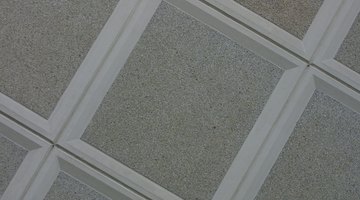Recommended Staplers for Ceiling Tiles
Table of Contents
The majority of ceiling tiles on the market are made from fiberboard: cane or waste-wood fibers pressed with a chemical binding agent into flat panels. By virtue of their less than dense nature, they are relatively light for their size, and this also makes them easy to staple through.

The substrate -- the material to which the tiles are to be stapled -- is what dictates how powerful the stapler must be.
Attachment Methods
Adhesion and stapling are the most common methods of ceiling tile attachment. Adhesives can only be used when the substrate is smooth and sound across the entire area to be tiled. For less than ideal situations, including exposed joists, furring strips are fastened to the substrate with shims, if necessary, to even out the surface. Furring strips are made from straight-grained soft woods, typically fur, pine or spruce, and these are a major factor in terms of stapler choice.
Ceiling Tile Staples
Special staples are designed for ceiling tiles. The blades on each end of the staple face in opposite directions so that when they pass through the wood, they flare out. This gives them tremendous holding power -- they are hanging upside-down and defying gravity -- without an insertion pressure so great that they pass through the relatively unresisting tile material. Typically, little more than 1/2-inch in length and manufactured to a standard width, they will fit into almost every stapler on the market.
Choosing the Stapler
Because furring strips are made from soft woods and ceiling staples are so short, the staplers used to attach the tiles do not need to be particularly strong. Power staplers are unnecessary; a regular hand-held device is entirely adequate. That said, the installer may wish to use a powered machine to minimize fatigue. Use three equally-spaced staples through each edge of a tile that abuts a furring strip. One staple should be in each corner, the third in the center of each edge.
Recommended Staplers
Numerous companies manufacture staplers that accept ceiling tiles and are strong enough to fasten them into furring strips. Typical of the handheld machines is the Arrow T50 Elite, which has an ergonomic design that delivers 60 percent more power than alternative models through an “easy-squeeze” design. The machine accepts six different staple sizes, including those sized for ceiling tiles. Typical of the powered machines is the Stanley electric staple, brad and nail gun. This has a high-low driving power switch to accommodate stapling into both hard and softer substrates, a specially-contoured nose for stapling right into corners and accepts staples sized for ceiling tiles.
Method
Install the furring strips cross-wise to the preexisting joists; center to center, the furring strips must be the exact width of the ceiling tiles apart. It is bad practice to start tiling one wall then cutting the opposite border row when you reach the opposite end; if cuts must be made, they should be made at both walls so that the partial rows match. Measure the length and width of the room and divide the measurements by the size of the tile then calculate how wide the border rows must be. Snap a chalk line to give you the starting place for one border row, cut the tiles to size then staple them into place. Work across the room with full rows until you reach the far wall, where the other partial row is fitted.
The Drip Cap
- The majority of ceiling tiles on the market are made from fiberboard: cane or waste-wood fibers pressed with a chemical binding agent into flat panels.
- By virtue of their less than dense nature, they are relatively light for their size, and this also makes them easy to staple through.
- Adhesion and stapling are the most common methods of ceiling tile attachment.
- For less than ideal situations, including exposed joists, furring strips are fastened to the substrate with shims, if necessary, to even out the surface.
- Because furring strips are made from soft woods and ceiling staples are so short, the staplers used to attach the tiles do not need to be particularly strong.
- Power staplers are unnecessary; a regular hand-held device is entirely adequate.
References
Resources
Writer Bio
John Cagney Nash began composing press releases and event reviews for British nightclubs in 1982. His material was first published in the "Eastern Daily Press." Nash's work focuses on American life, travel and the music industry. In 1998 he earned an OxBridge doctorate in philosophy and immediately emigrated to America.
Photo Credits
- Photos.com/Photos.com/Getty Images
- Photos.com/Photos.com/Getty Images
More Articles



